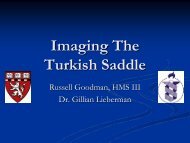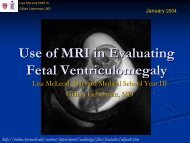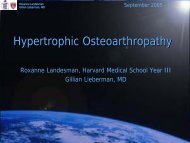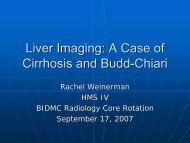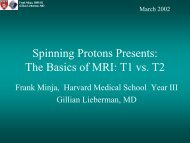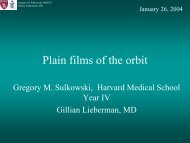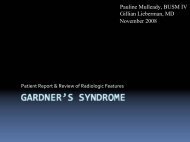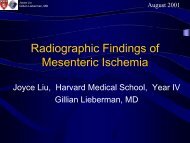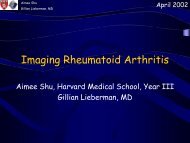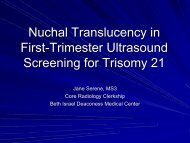The Radiology of Orbital Trauma - Lieberman's eRadiology ...
The Radiology of Orbital Trauma - Lieberman's eRadiology ...
The Radiology of Orbital Trauma - Lieberman's eRadiology ...
Create successful ePaper yourself
Turn your PDF publications into a flip-book with our unique Google optimized e-Paper software.
<strong>The</strong> <strong>Radiology</strong> <strong>of</strong><br />
<strong>Orbital</strong> <strong>Trauma</strong><br />
Carolyn Schook<br />
Harvard Medical School Year III<br />
1/26/2009<br />
BIDMC Core <strong>Radiology</strong> Clerkship<br />
Dr. Gillian Lieberman
<strong>The</strong> <strong>Radiology</strong> <strong>of</strong><br />
<strong>Orbital</strong> <strong>Trauma</strong><br />
Outline<br />
* Epidemiology <strong>of</strong> <strong>Orbital</strong> <strong>Trauma</strong><br />
* Orbit Anatomy<br />
* Imaging Indications in <strong>Orbital</strong> <strong>Trauma</strong><br />
* Menu <strong>of</strong> tests for <strong>Orbital</strong> <strong>Trauma</strong><br />
* "Cookbook Approach" to CT evaluation<br />
* "Differential Diagnosis" with interpretation<br />
* Application: Index Case<br />
* Summary
Epidemiology <strong>of</strong> <strong>Orbital</strong> <strong>Trauma</strong><br />
* 3% <strong>of</strong> all emergency department visits in the US*<br />
* Usually seen in patients with multiple trauma*<br />
* Most common in teens/young adults & males (upwards to 81%) ^*<br />
- Mechanism <strong>of</strong> action in children most <strong>of</strong>ten sports related<br />
orbital blow-out (floor)<br />
- Mechanism <strong>of</strong> action in older youth/adults assaults and<br />
MVA lateral (zygomatic) fractures & complex injuries<br />
Ref: *Kabul, ^UpToDate.com
Anatomy <strong>of</strong> <strong>Orbital</strong> <strong>Trauma</strong>: <strong>Orbital</strong> Bones<br />
Image ref: UpToDate.com
Anatomy <strong>of</strong> <strong>Orbital</strong> <strong>Trauma</strong>: S<strong>of</strong>t Tissue<br />
Image Ref: UpToDate.com
Anatomy <strong>of</strong> <strong>Orbital</strong> <strong>Trauma</strong>:<br />
Normal <strong>Orbital</strong> Anatomy on CT<br />
Axial non-contrast head CT at level <strong>of</strong> orbit<br />
AC = anterior chamber<br />
L = lens<br />
PS = posterior chamber<br />
ON = optic nerve within optic cone<br />
Image Ref: Right: UpToDate.com, Left: Kabul, W. "Imaging <strong>of</strong> <strong>Orbital</strong> <strong>Trauma</strong>“ Figure 2. RadioGraphics. (2008) 18:1729-2739.
Indications for Imaging in <strong>Orbital</strong> <strong>Trauma</strong><br />
* evidence <strong>of</strong> fracture on clinical examination<br />
* limitation <strong>of</strong> EOM<br />
* decreased visual acuity in setting <strong>of</strong> trauma<br />
* severe pain<br />
* inadequate examination due to s<strong>of</strong>t tissue swelling***<br />
Ref: UpToDate.com
Menu <strong>of</strong> Tests for <strong>Orbital</strong> <strong>Trauma</strong>:<br />
Plain Films<br />
• Sensitive for detecting orbital floor fractures ranges from ~<br />
50%^ to 78%*<br />
• Limited in ability to delineate s<strong>of</strong>t tissue structures #<br />
• Recommended as screening tool only with children who<br />
had minor mechanism as can show clouding <strong>of</strong> a sinus<br />
indicating either blood or fat extrusion from orbital floor<br />
fracture*<br />
Ref: *Kabul & # Lee
Menu <strong>of</strong> Tests for <strong>Orbital</strong> <strong>Trauma</strong>:<br />
Plain Films<br />
Frontal plain film <strong>of</strong> face<br />
Blue arrow:<br />
fluid density in<br />
maxillary<br />
sinus<br />
Yellow arrow:<br />
orbital floor<br />
fracture<br />
Image Ref: Ophthalmic emergencies.” Image 1. www.onlineabstract.com Radiological Congress. Manchester Central, Manchester, UK. 2007.
Menu <strong>of</strong> Tests for <strong>Orbital</strong> <strong>Trauma</strong>:<br />
Ultrasound<br />
* Insensitive for delineating fractures and lack <strong>of</strong> s<strong>of</strong>t tissue differentiation<br />
* Can decipher contents <strong>of</strong> the globe<br />
* Rarely used.<br />
Text Ref: Lee & Kabul<br />
* BUT: C/I if suspect a traumatized globe<br />
Ultrasound <strong>of</strong> right orbital globe<br />
Image Ref: http://www.ultrasound-images.com/eyes.htm<br />
Blue circle:<br />
hyperechoic<br />
density in orbit
Menu <strong>of</strong> Tests for <strong>Orbital</strong> <strong>Trauma</strong>:<br />
MRI<br />
* most sensitive <strong>of</strong> all tests for depiction <strong>of</strong> intraorbital contents ^*<br />
* insensitive for visualization <strong>of</strong> bony fragments ^<br />
* some foreign bodies not easily visible (esp. wood and glass) ^<br />
* not easily accessible and not appropriate for emergent patients<br />
* C/I if possible ferromagnetic foreign bodies within or near orbits ^<br />
* can be used after initial emergent trauma has abated *<br />
Text Ref: ^UpToDate.com & *Kabul
Menu <strong>of</strong> Tests for <strong>Orbital</strong> <strong>Trauma</strong>:<br />
General Head CT<br />
* Better than plain film and MRI at bony resolution<br />
* Much greater sensitivity than plain films for s<strong>of</strong>t tissues findings<br />
- sensitivity for ~75% for open globe *<br />
Ref *Kabul, rest <strong>of</strong> information from UpToDate.com
Modality <strong>of</strong> Choice for <strong>Orbital</strong> <strong>Trauma</strong>:<br />
Thin-Cut <strong>Orbital</strong> CT<br />
* can better visualize fractures, foreign bodies, and s<strong>of</strong>t tissue<br />
injuries over standard head CT ^<br />
* base <strong>of</strong> skull to vertex at thin sliced (0.625-1.25mm) axial CT<br />
and coronal images needed to evaluate the superior orbital<br />
surface, floor <strong>of</strong> orbit, SR and IR muscles, and identification<br />
<strong>of</strong> an optic nerve sheath hematoma *^<br />
via either<br />
* 3 mm coronal intervals coronal acquisition * OR<br />
* a subsequent multiplanar reformation if patient unable to sit<br />
prone for coronal acquisition *^<br />
Ref: ^Lee, *Kabul, & UpToDate.com
“Cookbook” Approach to Evaluation<br />
Start anteriorly then progress deep….<br />
1. evaluate for external s<strong>of</strong>t tissue changes<br />
2. evaluate anterior chamber<br />
3. evaluate position <strong>of</strong> the lens<br />
4. evaluate globe including posterior segment<br />
5. evaluate bony orbit for fractures<br />
6. evaluate for foreign bodies<br />
7. ** evaluate vessels and optic nerve<br />
8. ** always look for associated intracranial injury to CNS<br />
Ref: Kabul with edits
“Differential Diagnosis” <strong>of</strong> <strong>Orbital</strong> <strong>Trauma</strong>:<br />
S<strong>of</strong>t Tissue Changes<br />
- proptosis &/or orbital edema &/or hematoma suggestive <strong>of</strong><br />
underlying bony fractures or extrusion <strong>of</strong> intraocular contents<br />
from ruptured globe<br />
Axial non-contrast head CT at level <strong>of</strong> orbit<br />
Blue arrow:<br />
complex fluid<br />
density and<br />
s<strong>of</strong>t tissue<br />
swelling<br />
(hematoma)<br />
Text Ref: Kabul Picture Ref: ”A Site for Sore Eyes.” Image 1. www.onlineabstract.com Radiological Congress. Manchester Central, Manchester, UK. 2007.
“Differential Diagnosis” <strong>of</strong> <strong>Orbital</strong> <strong>Trauma</strong>:<br />
Anterior chamber injuries<br />
Corneal lacerations: (yellow arrow) look for decreased volume <strong>of</strong> anterior chamber<br />
- Hyphema: (blue arrow) look for increased attenuation in anterior chamber<br />
- Open globe: look for herniations <strong>of</strong> orbital contents especially at<br />
Text Ref: Kabul<br />
orbital apex<br />
Axial non-contrast head CTs at level <strong>of</strong> orbit<br />
Image Ref: Right Kabul, W. "Imaging <strong>of</strong> <strong>Orbital</strong> <strong>Trauma</strong>“ Figure 4. RadioGraphics. (2008) 18:1729-2739.<br />
Left: Courtesy <strong>of</strong> Dr. Gul Moonis, BIDMC and MEEI
“Differential Diagnosis” <strong>of</strong> <strong>Orbital</strong> <strong>Trauma</strong>:<br />
Lens Injury<br />
Subluxation/dislocation<br />
- posterior are more common as iris impedes anterior direction<br />
- look for lens floating within dependent portion <strong>of</strong> the vitreous humor<br />
- tends to pair with corneal lac<br />
- if b/l consider underlying condition (CT disease such as Marfan's)<br />
Text Ref: Kabul
“Differential Diagnosis” <strong>of</strong> <strong>Orbital</strong> <strong>Trauma</strong>:<br />
Lens Injury Examples<br />
Yellow arrow: complete dislocation <strong>of</strong> L lens in dependent portion <strong>of</strong> globe<br />
Blue arrow: lateral subluxation <strong>of</strong> R lens<br />
Axial non-contrast head CTs at level <strong>of</strong> orbit<br />
Image Ref: Kubal, W. "Imaging <strong>of</strong> <strong>Orbital</strong> <strong>Trauma</strong>“ Figures 5 & 6. RadioGraphics. (2008) 18:1729-2739.
“Differential Diagnosis” <strong>of</strong> <strong>Orbital</strong> <strong>Trauma</strong>:<br />
Open Globe Injuries<br />
Text Ref: Kabul<br />
- very emergent, a "must-not-miss" finding<br />
- most common at insertion <strong>of</strong> EOM where sclera is thinnest<br />
so look for scleral discontinuity<br />
- look for change in volume esp change in volume or "flat-tire sign”<br />
- intraocular air<br />
- Fake Out: for retinal detachment is to inject perfluoropropane gas<br />
into the vitreous and can mimic open globe free air
“Differential Diagnosis” <strong>of</strong> <strong>Orbital</strong> <strong>Trauma</strong>:<br />
Open Globe Injuries Examples<br />
Yellow arrows: s/p trauma with flat tire sign (thin arrow) and free air (thick arrows)<br />
Blue arrow: Fake out! patient s/p head trauma with orbital gas placed for detached retina<br />
Axial non-contrast head CT’s at level <strong>of</strong> orbit<br />
Image Ref: Kubal, W. "Imaging <strong>of</strong> <strong>Orbital</strong> <strong>Trauma</strong>" Figures 7 and 12. RadioGraphics. (2008) 18:1729-2739.
“Differential Diagnosis” <strong>of</strong> <strong>Orbital</strong> <strong>Trauma</strong>:<br />
Open Globe Injuries via Anterior Chamber Changes<br />
Yellow arrow: narrowed anterior chamber suggesting anterior ruptured globe (full corneal lac)<br />
Blue arrow: widened anterior chamber suggesting posterior ruptured globe with corresponding<br />
posteriorly extruding contents<br />
Image Ref: Courtesy <strong>of</strong> Dr. Gul Moonis, BIDMC and MEEI Axial non-contrast head CT’s at level <strong>of</strong> orbit
“Differential Diagnosis” <strong>of</strong> <strong>Orbital</strong> <strong>Trauma</strong>:<br />
Posterior Globe Injury<br />
Retinal injury/detachment:<br />
- collections <strong>of</strong> subretinal fluid leading to a "V” shaped configuration<br />
(blue arrow)<br />
Axial non-contrast head CT at level <strong>of</strong> orbit<br />
Text Ref: Kabul Image Ref: Kubal, W. "Imaging <strong>of</strong> <strong>Orbital</strong> <strong>Trauma</strong>" Figures 16. RadioGraphics. (2008) 18:1729-2739.
“Differential Diagnosis” <strong>of</strong> <strong>Orbital</strong> <strong>Trauma</strong>;<br />
<strong>Orbital</strong> Fractures Overview<br />
* Fracture to one or more walls <strong>of</strong><br />
the orbit, orbital rim, or both<br />
* Signs <strong>of</strong> orbital fracture on routine head CT include<br />
- non-anatomic linear lucencies<br />
- cortical defect<br />
- bone fragments overlapping causing a "double-density”<br />
- opacification <strong>of</strong> adjacent paranasal sinuses<br />
- asymmetry <strong>of</strong> face<br />
- periorbital subcutaneous emphysema<br />
- entrapment <strong>of</strong> extraocular muscles<br />
- injury to canthal ligament and/or lacrimal duct system<br />
# **<br />
Ref: #Lee, ^UpToDate.com, **Dolan
“Differential Diagnosis” <strong>of</strong> <strong>Orbital</strong> <strong>Trauma</strong>:<br />
<strong>Orbital</strong> zygomatic fracture<br />
* usually high-impact blow to lateral orbit - follows LeFort lines <strong>of</strong> resistance<br />
* look for assoc. fracture <strong>of</strong> orbital floor (maxillary bone)<br />
Yellow arrow: zygomatic fracture<br />
Left Image Ref: Dolan, K. "Facial and Mandibular Fractures" UW Department <strong>of</strong> <strong>Radiology</strong>.<br />
http://www.rad.washington.edu/academics/. This website and all its content are © 2007-2008 Axial non-contrast head CT at level <strong>of</strong> orbit<br />
Right Image Ref: Czerwinski, M.; Ma, S.; Williams, H. "Zygomatic Arch Deformation: An Anatomic and Clinical Study" Zygomatic Arch Deformation: An Anatomic<br />
and Clinical Study Journal <strong>of</strong> Oral and Maxill<strong>of</strong>acial Surgery (2008) 11: 2322-2329.
“Differential Diagnosis” <strong>of</strong> <strong>Orbital</strong> <strong>Trauma</strong>:<br />
Nasoethmoid fracture<br />
* occurs as medial wall is formed by papyracea (thin) bondy septum<br />
* look for assoc. disruption <strong>of</strong> medial canthal ligament, lacrimal duct system, and<br />
MR muscle (trapped in medial wall)<br />
- ex: Widened intracanthal distance disruption <strong>of</strong> medial canthal ligament<br />
Text Ref: UpToDate.com<br />
Axial non-contrast head CT at level <strong>of</strong> orbit<br />
Yellow arrow:<br />
left medial wall<br />
fracture<br />
Image Ref: Tonami, H.; Yamamoto, I.; Matsuda, M., Tamamura, H.; Yokota, H. Nakagawa, T., Takarada, A., * Okimura,<br />
T. "<strong>Orbital</strong> Fractures: Surface Coil MR Imaging.“ Image 1. Head and Neck <strong>Radiology</strong> (1991) 179: 789-794.
“Differential Diagnosis” <strong>of</strong> <strong>Orbital</strong> <strong>Trauma</strong>:<br />
<strong>Orbital</strong> floor fracture or "Blow-out” fracture<br />
* most common orbital facture #<br />
* typically occur when small round object (i.e. ball) strikes eye<br />
* floor formed by palatine and maxilla which is thin and with a<br />
central groove<br />
- in children look for linear pattern that snaps back (i.e. "trapdoor"<br />
effect) from flexible bone<br />
- in adults look for shattered bone<br />
* look for associated entrapment <strong>of</strong><br />
IR muscle or orbital fat &<br />
expect intraorbital nerve Sx ^<br />
Text Ref: Kabul & ^UpToDate.com. Ref, #Lee<br />
Image Ref: Dolan, K. "Facial and Mandibular Fractures" UW Department <strong>of</strong> <strong>Radiology</strong>.<br />
http://www.rad.washington.edu/academics/. This website and all its content are © 2007-2008
“Differential Diagnosis” <strong>of</strong> <strong>Orbital</strong> <strong>Trauma</strong>:<br />
<strong>Orbital</strong> floor fracture example<br />
Coronal non-contrast head CT at level <strong>of</strong> orbit<br />
Image: Mark Neuman, MD. "<strong>Orbital</strong> Fractures." wwww.UpToDate.com, October 1, 2008<br />
Black Arrow : inferior<br />
orbital wall (maxillary<br />
and/or palatine) fracture<br />
White Arrow: entrapped<br />
orbital contents can be<br />
seen in the maxillary sinus
“Differential Diagnosis” <strong>of</strong> <strong>Orbital</strong> <strong>Trauma</strong>:<br />
<strong>Orbital</strong> Ro<strong>of</strong> Fracture<br />
* more common pts < 10 yo<br />
* least common orbital fracture #<br />
* BUT: high assoc with intracranial injury !<br />
Coronal non-contrast head CT at level <strong>of</strong> orbit<br />
Yellow arrow: orbital ro<strong>of</strong> (frontal<br />
bone) fracture<br />
Text Ref: UpToDate.com & #Lee Image Ref: Lee, H.; Jilani, M.; Frohman, L.; Baker, S. "CT <strong>of</strong> orbital trauma." Emergency <strong>Radiology</strong>. (2004) 10: 168-172
“Differential Diagnosis” <strong>of</strong> <strong>Orbital</strong> <strong>Trauma</strong>:<br />
Intraorbital foreign bodies *^<br />
- thin sliced has can pick up 96% <strong>of</strong> 1.5mm glass bodies<br />
but only 48% <strong>of</strong> 0.5mm glass<br />
- Fake Out: buckle for scleral band can mimic foreign body<br />
Axial non-contrast head CT at level <strong>of</strong> orbit<br />
Yellow arrow: metal-density<br />
(scleral band) outside <strong>of</strong> bone<br />
mimicking penetrating injury in<br />
patient with head trauma<br />
Ref: *Kabul & ^UpToDate.com Image Ref: Kubal, W. "Imaging <strong>of</strong> <strong>Orbital</strong> <strong>Trauma</strong>" Figures 1 &13 RadioGraphics. (2008) 18:1729-2739.
Application: Patient with ball to left eye<br />
Now that you know about <strong>Orbital</strong> <strong>Trauma</strong> Imaging….<br />
What are your findings?<br />
Ref: Courtesy <strong>of</strong> Dr. Moonis, BIDMC & MEEI<br />
Coronal non-contrast head CT at level <strong>of</strong> orbit<br />
Yellow Arrow:<br />
orbital floor<br />
fracture with<br />
entrapment <strong>of</strong><br />
inferior rectus<br />
and fat<br />
Blue Arrow:<br />
repair with rib<br />
reconstruction
Application: Patient with blunt trauma to left eye<br />
Now that you know about <strong>Orbital</strong> <strong>Trauma</strong> Imaging….<br />
What are your findings?<br />
Ref: Courtesy <strong>of</strong> Dr. Moonis, BIDMC & MEEI<br />
Coronal non-contrast head CT at level <strong>of</strong> orbit<br />
Blue Arrow:<br />
comminuted<br />
orbital floor blow-<br />
out<br />
Yellow Arrow:<br />
medial wall fracture<br />
with medial rectus<br />
entrapment
Application: Patient with blunt trauma posterior skull<br />
Now that you know about <strong>Orbital</strong> <strong>Trauma</strong> Imaging….<br />
What are your findings?<br />
Axial non-contrast head CT at level <strong>of</strong> orbit<br />
Ref: Courtesy <strong>of</strong> Dr. Moonis, BIDMC & MEEI<br />
Blue Arrow:<br />
Comminuted<br />
posterior wall<br />
orbital blow in<br />
fracture
Application: Patients in motor vehicle accident<br />
Now that you know about <strong>Orbital</strong> <strong>Trauma</strong> Imaging….<br />
What are your findings?<br />
Axial non-contrast head CT’s at level <strong>of</strong> orbit<br />
Ref: Courtesy <strong>of</strong> Dr. Moonis, BIDMC & MEEI<br />
Blue Arrow:<br />
Flat Tire Sign<br />
designating<br />
ruptured globe
Application: Patient with blunt trauma to right eye<br />
Now that you know about <strong>Orbital</strong> <strong>Trauma</strong> Imaging….<br />
What are your findings?<br />
Axial non-contrast head CT at level <strong>of</strong> orbit<br />
Ref: Courtesy <strong>of</strong> Dr. Moonis, Moonis BIDMC & MEEI<br />
Blue Arrow:<br />
Posterior lens<br />
dislocation
Summary:<br />
<strong>Orbital</strong> <strong>Trauma</strong> Imaging<br />
* Epidemiology <strong>of</strong> <strong>Orbital</strong> <strong>Trauma</strong> -- young adults in MVA or children in sports<br />
* Orbit Anatomy -- bony orbit and s<strong>of</strong>t tissue apparatus <strong>of</strong> eye<br />
* Imaging Indications in <strong>Orbital</strong> <strong>Trauma</strong> -- any trauma or severe pain<br />
* Menu <strong>of</strong> tests for <strong>Orbital</strong> <strong>Trauma</strong> -- CT is emergent modality <strong>of</strong> choice<br />
* "Cookbook Approach" to CT evaluation -- from superficial skin deep to back <strong>of</strong> orbit<br />
* "Differential Diagnosis" with interpretation -- must not miss: open-globe
References:<br />
* Lee, H.; Jilani, M.; Frohman, L.; Baker, S. "CT <strong>of</strong> orbital trauma." Emergency <strong>Radiology</strong>. (2004) 10: 168-172<br />
* Kubal, W. "Imaging <strong>of</strong> <strong>Orbital</strong> <strong>Trauma</strong>" RadioGraphics. (2008) 18:1729-2739.<br />
* Tonami, H.; Yamamoto, I.; Matsuda, M., Tamamura, H.; Yokota, H. Nakagawa, T., Takarada, A., * Okimura,<br />
T. "<strong>Orbital</strong> Fractures: Surface Coil MR Imaging." Head and Neck <strong>Radiology</strong> (1991) 179: 789-794.<br />
* Czerwinski, M.; Ma, S.; Williams, H. "Zygomatic Arch Deformation: An Anatomic and Clinical Study"<br />
Zygomatic Arch Deformation: An Anatomic and Clinical Study Journal <strong>of</strong> Oral and Maxill<strong>of</strong>acial Surgery (2008)<br />
11: 2322-2329.<br />
* "<strong>Orbital</strong> Fractures" wwww.UpToDate.com, October 1, 2008 (abbreviated in presentation as “UTD”)<br />
* Dolan, K. "Facial and Mandibular Fractures" UW Department <strong>of</strong> <strong>Radiology</strong>.<br />
http://www.rad.washington.edu/academics/. This website and all its content are © 2007-2008<br />
*Ophthalmic emergencies.” Image 1. <strong>The</strong> Online Abstract Radiological Congress. Manchester Central,<br />
Manchester, UK. 2007.
Acknowledgements<br />
Dr. Jonathan Kleefield & Dr. Doug Teich for guidance<br />
Dr. Gul Moonis for guidance and help with image obtainment



